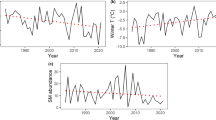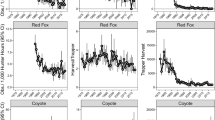Abstract
For many organisms, climate change can directly drive population declines, but it is less clear how such variation may influence populations indirectly through modified biotic interactions. For instance, how will climate change alter complex, multi-species relationships that are modulated by climatic variation and that underlie ecosystem-level processes? Caribou (Rangifer tarandus), a keystone species in Newfoundland, Canada, provides a useful model for unravelling potential and complex long-term implications of climate change on biotic interactions and population change. We measured cause-specific caribou calf predation (1990–2013) in Newfoundland relative to seasonal weather patterns. We show that black bear (Ursus americanus) predation is facilitated by time-lagged higher summer growing degree days, whereas coyote (Canis latrans) predation increases with current precipitation and winter temperature. Based on future climate forecasts for the region, we illustrate that, through time, coyote predation on caribou calves could become increasingly important, whereas the influence of black bear would remain unchanged. From these predictions, demographic projections for caribou suggest long-term population limitation specifically through indirect effects of climate change on calf predation rates by coyotes. While our work assumes limited impact of climate change on other processes, it illustrates the range of impact that climate change can have on predator–prey interactions. We conclude that future efforts to predict potential effects of climate change on populations and ecosystems should include assessment of both direct and indirect effects, including climate–predator interactions.


Similar content being viewed by others
References
Atwood TC et al (2007) Comparative patterns of predation by cougars and recolonizing wolves in Montana’s Madison range. J Wildl Manag 71:1098–1106
Bastille-Rousseau G (2015) Demography and habitat selection of Newfoundland caribou, PhD thesis, Trent University, p 248
Bastille-Rousseau G et al (2011) Foraging strategies by omnivores: are black bears actively searching for ungulate neonates or are they simply opportunistic predators? Ecography (Cop.) 34:588–596
Bastille-Rousseau G et al (2013) Population decline in semi-migratory caribou (Rangifer tarandus): intrinsic or extrinsic drivers? Can J Zool 91:820–828
Bastille-Rousseau G et al (2015) Unveiling trade-offs in resource selection of migratory caribou using a mechanistic movement model of availability. Ecography (Cop.) 38:1049–1059
Bastille-Rousseau G et al (2016a) Temporal variation in habitat use, co-occurrence, and risk among generalist predators and a shared prey. Can J Zool 94:191–198
Bastille-Rousseau G et al (2016b) Phase-dependent climate–predator interactions explain three decades of variation in neonatal caribou survival. J Anim Ecol 85:445–456
Bateman BL et al (2012) Biotic interactions influence the projected distribution of a specialist mammal under climate change. Divers Distrib 18:861–872
Beaumont LJ et al (2008) Why is the choice of future climate scenarios for species distribution modelling important? Ecol Lett 11:1135–1146
Bellard C et al (2012) Impacts of climate change on the future of biodiversity. Ecol Lett 15:365–377
Boudreau S, Payette S (2004) Caribou-induced changes in species dominance of lichen woodlands: an analysis of plant remains. Am J Bot 91:422–429
Brook BW et al (2008) Synergies among extinction drivers under global change. Trends Ecol Evol 23:453–460
Burnham KP, Anderson DR (2002) Model selection and multimodel inference. Springer, New York
Coulson T et al (2000) The relative roles of density and climatic variation on population dynamics and fecundity rates in three contrasting ungulate species. Proc R Soc B Biol Sci 267:1771–1779
Couturier S et al (2009a) Variation in calf body mass in migratory caribou: the role of habitat, climate, and movements. J Mammal 90:442–452
Couturier S et al (2009b) Body-condition dynamics in a northern ungulate gaining fat in winter. Can J Zool 87:367–378
Cox DR, Snell EJ (1989) Analysis of binary data. Chapman and Hall, London
Dell AI et al (2014) Temperature dependence of trophic interactions are driven by asymmetry of species responses and foraging strategy (M Humphries, Ed.). J Anim Ecol 83:70–84
Environment Canada (2013) National climate data and information archive
Festa-Bianchet M et al (2011) Conservation of caribou (Rangifer tarandus) in Canada: an uncertain future. Can J Zool 89:419–434
Fieberg J, Delgiudice GD (2009) What time is it? Choice of time origin and scale in extended proportional hazards models. Ecology 90:1687–1697
Fox J (2002) An R and S-Plus companion to applied regression. SAGE Publications Inc, Thousand Oaks
Gaillard JM et al (2000) Temporal variation in fitness components and population dynamics of large herbivores. Annu Rev Ecol Evol Syst 31:367–393
Griffin KA et al (2011) Neonatal mortality of elk driven by climate, predator phenology and predator community composition. J Anim Ecol 80:1246–1257
Gustine DD et al (2006) Calf survival of woodland caribou in a multi-predator ecosystem. Wildl Monogr 165:1–32
Hansen BBB et al (2013) Climate events synchronize the dynamics of a resident vertebrate community in the high arctic. Science 67:313–315
Heisey DM, Patterson BR (2006) A review of methods to estimate cause-specific mortality in presence of competing risks. J Wildl Manag 70:1544–1555
Heller NE, Zavaleta ES (2009) Biodiversity management in the face of climate change: a review of 22 years of recommendations. Biol Conserv 142:14–32
Hellmann JJ et al (2008) Five potential consequences of climate change for invasive species. Conserv Biol 22:534–543
James ARC et al (2004) Spatial separation of caribou from moose and its relation to predation by wolves. J Wildl Manag 68:799–809
Joly K et al (2011) Linkages between large-scale climate patterns and the dynamics of Arctic caribou populations. Ecography (Cop.) 34:345–352
La Sorte FA, Jetz W (2010) Projected range contractions of montane biodiversity under global warming. Proc Biol Sci 277:3401–3410
Lacy RC, Pollak JP (2014) Vortex: a stochastic simulation of the extinction process. Version 10.0. Chicago Zoological Society
Lunn M, McNeil D (1995) Applying Cox regression to competing risks. Biometrics 51:524–532
Mahoney SP, Schaefer JA (2002) Long-term changes in demography and migration of Newfoundland caribou. J Mammal 83:957–963
Mahoney SP et al (1990) Woodland caribou calf mortality in insular Newfoundland. Int Congr Game Biol 19:592–599
Mahoney SP et al (2011) Morphological change in Newfoundland caribou: effects of abundance and climate. Rangifer 31:21–34
Manchester S, Bullock J (2000) The impacts of non-native species on UK biodiversity and the effectiveness of control. J Appl Ecol 37:845–864
McGrath M (2004) The Newfoundland coyote. DRC Pub
McKenney DW et al (2011) Customized spatial climate models for North America. Bull Am Meteorol Soc 92:1611–1622
Mills LS et al (2013) Camouflage mismatch in seasonal coat color due to decreased snow duration. Proc Natl Acad Sci USA 110:11660
Mumma MA et al (2014) Enhanced understanding of predator-prey relationships using molecular methods to identify predator species, individual and sex. Mol Ecol Resour 14:100–108
Mumma MA et al (2016) A comparison of morphological and molecular diet analyses of predator scats. J Mammal (in press)
Murray D et al (1995) Hunting behaviour of a sympatric felid and canid in relation to vegetative cover. Anim Behav 50:1203–1210
Newton EJ et al (2014) Remote sensing reveals long-term effects of caribou on tundra vegetation. Polar Biol 37:715–725
Nilsen E, Linnell J (2009) Climate, season, and social status modulate the functional response of an efficient stalking predator: the Eurasian lynx. J Anim Ecol 78:741–751
Öhlund G et al (2014) Temperature dependence of predation depends on the relative performance of predators and prey. Proc R Soc Lond B Biol Sci (in press)
O’Quigley J et al (2005) Explained randomness in proportional hazards models. Stat Med 24:479–489
Owen-Smith N (2014) Spatial ecology of large herbivore populations. Ecography (Cop.) 37:416–430
Peers MJL et al (2014) Prey switching as a means of enhancing persistence in predators at the trailing southern edge. Glob Change Biol 20:1126–1135
Pettorelli N et al (2005) The relative role of winter and spring conditions: linking climate and landscape-scale plant phenology to alpine reindeer body mass. Biol Lett. 1:24–26
Pettorelli N et al (2007) Early onset of vegetation growth vs. rapid green-up: impacts on juvenile mountain ungulates. Ecology 88:381–390
Pinard V et al (2012) Calving rate, calf survival rate, and habitat selection of forest-dwelling caribou in a highly managed landscape. J Wildl Manag 76:189–199
Post E, Forchhammer MC (2008) Climate change reduces reproductive success of an Arctic herbivore through trophic mismatch. Philos Trans R Soc B Biol Sci 363:2369–2375
Post ES, Klein DR (1996) Relationships between graminoid growth form and levels of grazing by caribou (Rangifer tarandus) in Alaska. Oecologia 107:364–372
Post E et al (1999) Ecosystem consequences of wolf behavioural response to climate. Nature 401:905–907
Raupach MR et al (2007) Global and regional drivers of accelerating CO2 emissions. Proc Natl Acad Sci USA 104:10288–10293
Réale D et al (2003) Genetic and plastic responses of a northern mammal to climate change. Proc Biol Sci 270:591–596
Robertson BA et al (2013) Ecological novelty and the emergence of evolutionary traps. Trends Ecol Evol 28:552–560
Schaefer JA, Mahoney SP, Weir JN, Luther JG, Soulliere CE (2016) Decades of habitat use reveal food limitation of Newfoundland caribou. J Mammal 97:386–393
Sih A et al (2011) Evolution and behavioural responses to human-induced rapid environmental change. Evol Appl 4:367–387
Simberloff D (2006) Invasional meltdown 6 years later: important phenomenon, unfortunate metaphor, or both? Ecol Lett 9:912–919
Simberloff D, B Von Holle (1999) Positive interactions of nonindigenous species: invasional meltdown? Biol Invasions 1:21–32
Simberloff D et al (2013) Impacts of biological invasions: what’s what and the way forward. Trends Ecol Evol 28:58–66
Stenseth NC et al (2002) Ecological effects of climate fluctuations. Science 297:1292–1296
Stenseth NC et al (2004) Snow conditions may create an invisible barrier for lynx. Proc Natl Acad Sci USA 101:10632–10634
Travis JMJ (2003) Climate change and habitat destruction: a deadly anthropogenic cocktail. Proc R Soc B Biol Sci 270:467–473
Tyler NJC (2010) Climate, snow, ice, crashes, and declines in populations of reindeer and caribou (Rangifer tarandus L.). Ecol Monogr 80:197–219
Tylianakis JM et al (2008) Global change and species interactions in terrestrial ecosystems. Ecol Lett 11:1351–1363
Van der Putten WH et al (2010) Predicting species distribution and abundance responses to climate change: why it is essential to include biotic interactions across trophic levels. Philos Trans R Soc B Biol Sci 365:2025–2034
Vors LS, Boyce MS (2009) Global declines of caribou and reindeer. Glob Change Biol 15:2626–2633
Vucic-Pestic O et al (2011) Warming up the system: higher predator feeding rates but lower energetic efficiencies. Glob Chang Biol 17:1301–1310
Walther G et al (2002) Ecological responses to recent climate change. Nature 416:389–395
Weir JN et al (2014) Caribou data synthesis—Progress Report #2. Status of the Newfoundland population of woodland caribou. Technical Bulletin No. 008. Sustainable Development and Strategic Science, Department of Environment and Conservation, Government of Newfoundland and Labrador
Zager P, Beecham J (2006) The role of American black bears and brown bears as predators on ungulates in North America. Ursus 17:95–108
Zimova M et al (2016) High fitness costs of climate change-induced camouflage mismatch (J Lawler, Ed.). Ecol Lett 19:299–307
Acknowledgements
This project was a component of the Newfoundland & Labrador Caribou Strategy, 2008–2013. This study was funded by the Institute for Biodiversity, Ecosystem Science & Sustainability; the Sustainable Development & Strategic Science Division of the Newfoundland & Labrador Department of Environment & Conservation; and the Safari Club International Foundation. G. Bastille-Rousseau was supported by a scholarship from the Natural Sciences and Engineering Research Council of Canada. We thank K. P. Lewis for comments on an earlier version of this manuscript. We thank the Newfoundland & Labrador Department of Environment & Conservation for providing these long-term survival data as well as the efforts of many government personnel in the caribou captures and monitoring over the last four decades. Funding was provided by NSERC.
Author information
Authors and Affiliations
Contributions
GBR, JAS, and DLM designed the study. MJLP, EHE, MAM, NDR and SPM collected and provided data. GBR performed the analysis with assistance from MJLP, EHE and DLM. GBR drafted the manuscript with inputs from all co-authors.
Corresponding author
Additional information
Communicated by Ilpo Kojola.
Electronic supplementary material
Below is the link to the electronic supplementary material.
Rights and permissions
About this article
Cite this article
Bastille-Rousseau, G., Schaefer, J.A., Peers, M.J.L. et al. Climate change can alter predator–prey dynamics and population viability of prey. Oecologia 186, 141–150 (2018). https://doi.org/10.1007/s00442-017-4017-y
Received:
Accepted:
Published:
Issue Date:
DOI: https://doi.org/10.1007/s00442-017-4017-y




